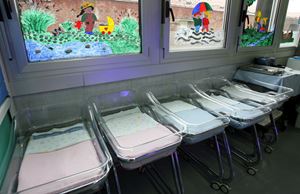Italy continues to record a drop in the resident population: As of January 1, 2025 there are 58.93 million inhabitants, with a loss of 37 thousand units compared to the previous year. This decline is mainly due to the decrease in births, which remain on historically low levels, and one of the lowest fertility rate in Europe.
A now structural demographic drop
The average number of children per woman in 2023 fell to 1.20, in additional decrease compared to 2022 (1.24). This drop is widespread throughout the national territory, with particularly low values in the center (1.12) and in the North-West (1.20). The Italian figure remains among the most critical in Europe, with a rate lower than that of France (1.79) and Germany, and near Spain (1.16) and Malta (1.08). In parallel, the average age of mothers at the first birth has further risen, passing from 32.4 years in 2022 to 32.5 in 2023. This figure reflects a consolidated trend: Italian women become mothers and later, often for economic and social reasons, negatively influencing the total number of births.

Immigration mitigates the decline
On the mortality front, 2023 recorded 660,600 deaths, with a 7.6% reduction compared to the previous year. This value marks a return close to the pre-pandemic levels of 2019, after the critical years of the pandemic. Life expectancy is growing: in 2023 it was estimated at 81.1 years for men and 85.2 years for women, earning about six months compared to 2022.
However, the aging process of the population continues: Italy remains one of the countries with the highest share of elderly, with significant implications for the pension and health system.
One of the few factors that contribute to containing the drop in the population is immigration. In 2023, registrations from abroad were 415,556, slightly increased (+1.1%) compared to 2022. In parallel, the internal residence transfers between Italian municipalities remained stable, with 1.44 million movements. The main internal migratory director remains that from the South and from the islands to the Center-North.

How to reverse the course?
«The picture outlined by Istat is worrying. Structural, generous and universal policies oriented to family and young people are urgent, “he comments Adriano Bordignon, president of the National Forum of Family Associations. He adds: «He worries the demographic drop in births, equal to -2.6%. With 1.18 children per woman in 2024, the fertility rate is at historic lows. The natural balance, or the difference between births and deaths, continues to be strongly negative (-281 thousand). We are sinking into mobile sands and it is clear that what we are putting on the field, as a system-Italy, is completely insufficient to guarantee a minimum demographic balance. For years we have been asking for a revolution that our country has not yet been willing to assume, victim of priorities that are always others, of lack of transparent convergences, of fragility of alliances between politics, local administration, association work and school. But also asphyxiated policies and tied to stringent budget pacts that instead become flexible for other emergencies ».
Bordignon relaunches on a theme: «The year of the family always seems to be the neighbor on agendas now gripped by world crisis that today also lead us to talk about war, military or duties, as a possibility of ordinary scenario. The number of Italians who leave the Belpaese is still growing. In 2024 there were 156 thousand, a +36.5% with an even more significant impact for the South, also burdened by the phenomenon of internal migrations: -52 thousand, while the North gains 47 thousand residents thanks to transfers from other areas of the country. Istat tells us that the average number of family members dropped to 2.2, compared to 2.6 of twenty years ago. Today over a third of the personal families in Italy is made up of a single person highlighting that the theme of the solitudes grows worryingly. Couples with children represent less than 30%, while monogenitarian families (10.8%) and children (20.2%) increase. We are consuming the future in an era that is pride of always looking for sustainability. Structural, generous and universal -oriented family policies are urgent. In this sense, the courage, the unity and the ability to plan to make, immediately, the consequent operational choices, considering the expense to grow the child, not as an individual cost but as an investment for the future of the entire community, is needed. Culture must be changed and support the family as a social subject who, if put in conditions, is capable of generating well -being for the whole country ».










